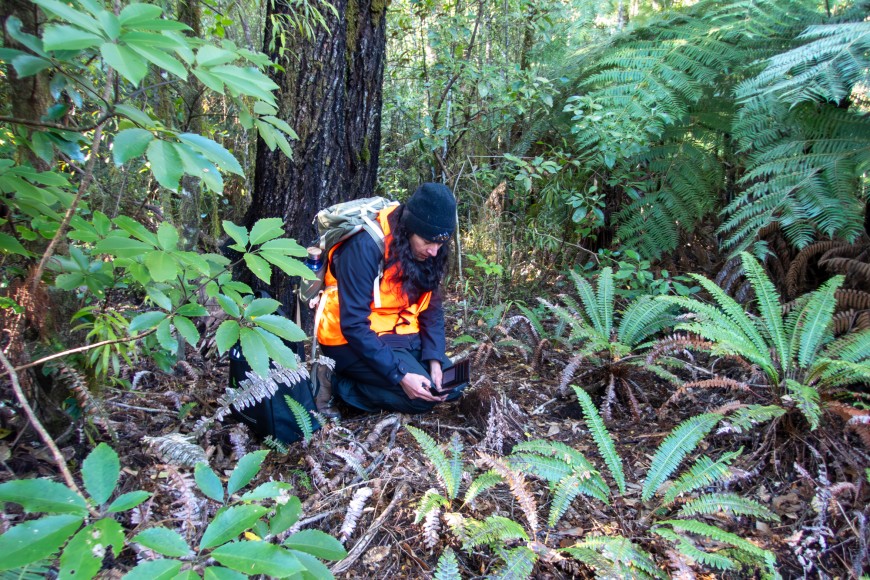Organised by FUNNZ, the Fungal Network of New Zealand, and supported by Manaaki Whenua, the week is an opportunity for researchers to collectively advance the knowledge of fungi in New Zealand, of which about 80% of species remain unknown.
The mycologists scoured the forests around Pelorus Bridge, Mt Richmond Forest Park, and various scenic reserves around Ngakuta and Momorangi Bays hoping to find as many specimens as possible. “Every year we find at least one new species,” says Dr Mahajabeen Padamsee, Manaaki Whenua researcher and New Zealand Fungarium (PDD) Te Kohinga Hekaheka o Aotearoa curator.

PDD Curator Mahajabeen Padamsee in the forest at Pelorus Bridge Scenic Reserve
During the week, all the fungi were photographed, with some dried and packed up to be added to the national fungal collection in Auckland. Researchers also dissected specimens, prepared material for DNA extraction and generated cultures from species of interest.
By the end of the week at least 200 samples were packed up for the Collection. “This event allows us to add information about what’s found in a particular area which is useful information that we can use to monitor what’s here from a conservation perspective,” says Mahajabeen.
While much of the specimen haul is still to be processed, there were some unusual finds.
Mycologist Dr Bevan Weir says one was identifying specimens of the Tubaria species. “This is commonly called Tubaria rufofulva (as used in Australia), but DNA sequences from this foray show that it is a related, but undescribed endemic species.”
Some lumpy blobs found on rotting wood at Pelorus Bridge were interesting for mycologist Dr Peter Johnston, a specialist in the study of ascomycetes, a class of fungi characterised by their spore-producing structures called asci. They could potentially have been an unnamed genus. “The black fruiting bodies are distinctively sculptured with a series of ridges extending from a tiny pore at the centre. Its morphology indicated it could perhaps be related to the New Zealand endemic, monotypic Induratia apiospora, a genus and species known from only one collection made from rotting wood in the Waipoua Forest, way back in 1982.”

At the 2024 Fungal Foray the fungi are photographed, with some dried and packed up to be added to the national fungal collection, the New Zealand Fungarium (PDD) Te Kohinga Hekaheka o Aotearoa in Auckland. Researchers also dissect specimens, prepare material for DNA extraction and generate cultures from species of interest.
Which is where DNA technology proves its worth. Once researchers had DNA sequences from the cultures, the fungi were identified as Rimaconus coronatus, a relatively newly described species in New Zealand.
Every year the researchers also hope to inspire a new generation of mycologists with visits to the foray headquarters by schools in the area. Manaaki Whenua mycologist Dr Peter Buchanan helped a group of Year 6-8 students from Havelock School take a close look at the specimen table. Dr Buchanan says the visits are important because they open new worlds for the students. “Children are typically curious and with their sharp eyes, and being closer to the ground, fungi are very accessible. It would be nice to see children become as observant of fungi as they are of birds and insects.”

![Blue entoloma [Entoloma hochstetteri]](/assets/Tools-And-Resources/collections/Fungi-Blue-entaloma__FillMaxWzMwMCwyMDBd.jpg)
